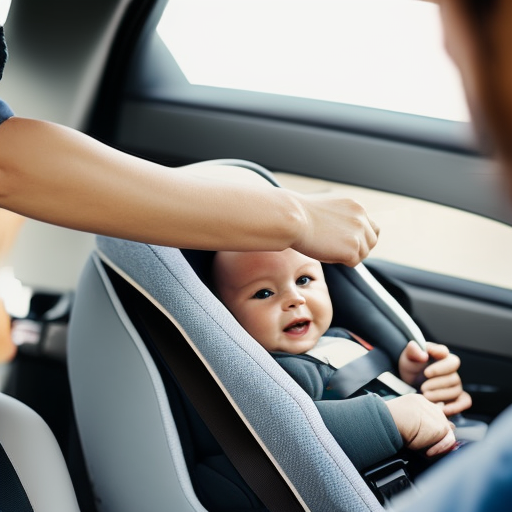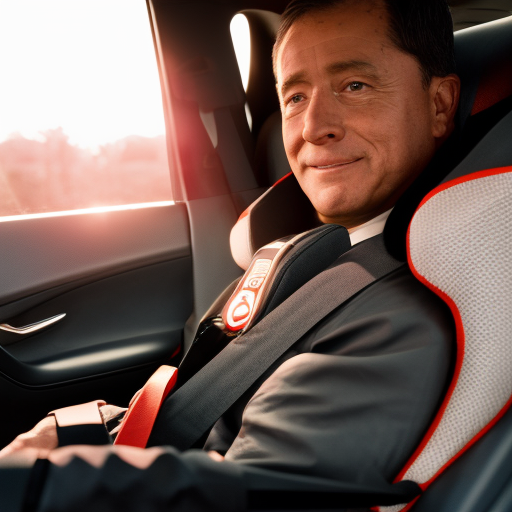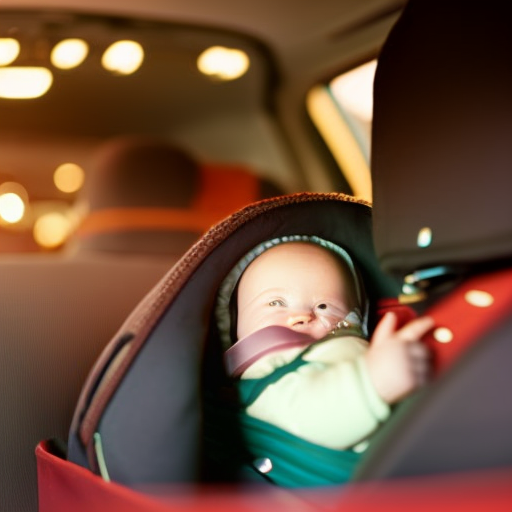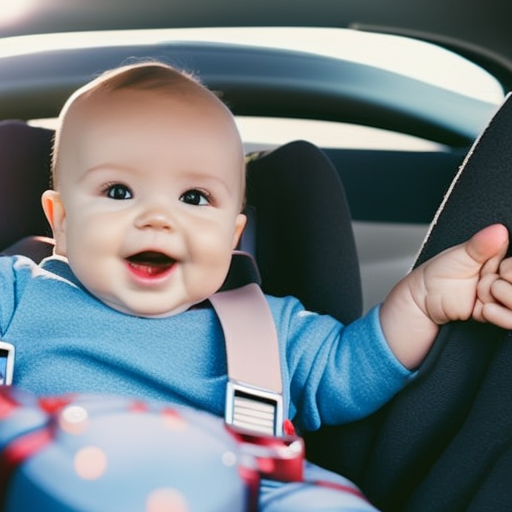"Cherishing Little Steps - A Haven for Baby and Family Journeys"
Choosing the Safest Car Seats
Are you a parent who wants nothing but the absolute best for your precious little one? When it comes to keeping them safe on the road, you can’t afford to compromise.
That’s why choosing the safest car seats is of utmost importance. From crash test ratings to proper fit for your child’s age and size, there are several factors to consider. Look out for safety features like the LATCH and harness systems, which provide an extra layer of security.
And don’t forget about extended rear-facing car seats and booster seats as your child grows. With so much at stake, making the right choice for your child’s safety is non-negotiable.
Key Takeaways
- Check crash test ratings and installation guidelines provided by regulatory bodies like FMVSS 213.
- Ensure proper fit for your child’s age and size, considering weight and height requirements specified by the car seat manufacturer.
- Look for safety features such as reinforced steel frame, energy-absorbing materials, five-point harness system, and side-impact protection.
- Consider different types of car seats, including rear-facing, forward-facing, combination, convertible, and booster seats, based on your child’s age and developmental stage.
Crash Test Ratings

When choosing the safest car seats, you should always check the crash test ratings. These ratings provide valuable information about the car seat’s ability to protect your child in the event of a crash. Crash test standards are set by regulatory bodies to ensure that car seats meet minimum safety requirements.
The most common crash test standard is the Federal Motor Vehicle Safety Standard (FMVSS) 213, which evaluates the performance of child restraints in frontal and side-impact crashes.
To assess the crashworthiness of a car seat, it undergoes rigorous testing using specialized dummies that simulate the size and weight of a child. The dummies are equipped with sensors that measure the forces experienced during a crash. These forces are then compared to the established safety thresholds to determine if the car seat provides adequate protection.
In addition to crash test ratings, it’s important to consider the presence of child seat anchors in your vehicle. These anchors, also known as LATCH (Lower Anchors and Tethers for Children), provide a secure attachment point for the car seat. They make installation easier and reduce the risk of improper installation, which can compromise the effectiveness of the car seat in a crash.
Ease of Installation

To ensure a secure and hassle-free installation, it’s important for you to consider the ease of installation when choosing a car seat. The convenience factors associated with installing a car seat can greatly impact your overall experience and the safety of your child. Here are five key factors to consider:
-
LATCH System Compatibility: Look for car seats that are compatible with the Lower Anchors and Tethers for Children (LATCH) system. This system allows for easier and more secure installation by eliminating the need for seat belts.
-
Clear Installation Instructions: Make sure the car seat comes with clear and easy-to-follow installation instructions. Clear diagrams and step-by-step guidance can greatly simplify the installation process.
-
User-Friendly Features: Look for car seats with user-friendly features, such as adjustable straps and easy-to-use buckles. These features can save you time and frustration during installation.
-
Quick and Secure Installation: Consider car seats that offer quick and secure installation mechanisms. Some car seats use push-button connectors or self-ratcheting LATCH systems, making installation a breeze.
-
Compatibility with Different Vehicles: Ensure the car seat is compatible with different types of vehicles. This will allow you to easily transfer the car seat between multiple vehicles without compromising safety.
Considering these ease of installation factors won’t only save you time and effort but also ensure that your child is safely secured in the car seat. Choose a car seat that prioritizes convenience and ease of installation to provide a stress-free experience for both you and your little one.
Proper Fit for Child’s Age
For optimal safety, it’s crucial to ensure that the car seat provides a proper fit for your child’s age. This means taking into consideration your child’s weight and height requirements when selecting a car seat. The weight and height limits specified by the car seat manufacturer are important factors to consider, as they determine whether the seat will provide adequate protection for your child.
When it comes to weight requirements, car seats are typically categorized into different groups. Infant car seats are designed for babies weighing up to 35 pounds, while convertible car seats can accommodate both infants and toddlers weighing up to 40 pounds. Booster seats, on the other hand, are suitable for children weighing between 40 and 80 pounds, depending on the specific model.
Height requirements are equally important. You should ensure that your child’s head isn’t above the top of the seat, as this can result in inadequate protection in the event of a collision. Additionally, the harness straps should be positioned at or slightly below your child’s shoulders to ensure a secure fit.
Proper Fit for Child’s Size
To ensure optimal safety, you must ensure that the car seat properly fits your child’s size. The proper fit is crucial in providing the necessary protection and minimizing the risk of injury during a car ride. Here are some key factors to consider when fitting the car seat for your child’s size:
-
Importance of adjustable headrests: The car seat should have adjustable headrests that can be positioned to align with your child’s head. This ensures that the headrest provides maximum support and protection in the event of a sudden stop or collision.
-
Proper positioning of shoulder straps: The shoulder straps should be positioned correctly to secure your child in the car seat. They should be snug but not too tight, allowing your child to move comfortably while still providing the necessary restraint in case of an accident.
-
Properly adjusted seat height: The car seat should be adjusted to the appropriate height for your child. This ensures that the seat belt or harness is properly positioned across your child’s body, preventing any potential injuries caused by improper restraint.
-
Secure fit with the vehicle seat: The car seat should have a secure fit with the vehicle seat, without any excessive movement or wobbling. This ensures that the car seat remains stable during the journey, reducing the risk of injury in case of sudden movements or impacts.
-
Consider your child’s weight and height: It’s important to consider your child’s weight and height when selecting a car seat. Different car seats are designed to accommodate specific weight and height ranges, so choosing the right one ensures a proper fit and maximum safety for your child.
Safety Features to Look For

When choosing the safest car seat for your child, it’s important to consider the key safety features that provide optimal protection. Two crucial features to look for are car seat expiration and side impact protection.
Car seat expiration refers to the recommended lifespan of the car seat. Over time, the materials used in car seats can degrade, compromising their effectiveness in a crash. It’s essential to check the expiration date of the car seat and replace it accordingly. This ensures that your child has the highest level of protection during their early years.
Side impact protection is another critical safety feature to consider. Side impact crashes can be particularly dangerous for children, as they’re vulnerable to severe injuries. Look for a car seat that offers enhanced side impact protection, such as deep side wings and energy-absorbing materials. These features help to absorb and distribute the forces of a crash, reducing the risk of injury to your child.
Types of Car Seats

As you consider the safest car seat for your child, it’s important to understand the different types of car seats available. Here are five key points to help you make an informed decision:
-
Rear-Facing Installation: Rear-facing car seats are designed to protect infants and young children in the event of a crash. They provide excellent support for the head, neck, and spine, reducing the risk of serious injury.
-
Forward-Facing Installation: Once your child has outgrown the rear-facing car seat, it’s time to transition to a forward-facing car seat. These seats offer added protection for the upper body and are suitable for toddlers and young children.
-
Combination Car Seats: Combination car seats can be used in both rear-facing and forward-facing modes, offering versatility as your child grows. They typically have higher weight and height limits than infant car seats.
-
Convertible Car Seats: Convertible car seats can be used in both rear-facing and forward-facing positions, making them ideal for long-term use. They often have higher weight and height limits and can accommodate infants through to toddlers.
-
Booster Seats: Booster seats are designed for older children who’ve outgrown their car seats but aren’t yet tall enough to use a seat belt alone. They elevate the child, positioning the seat belt correctly over their lap and shoulder.
Remember to choose the right size car seat based on your child’s age, weight, and height. By understanding these different types of car seats, you can ensure that your child travels safely and comfortably.
Rear-Facing Vs. Forward-Facing Seats

Consider the following factors to determine which car seat is the safest choice for your child:
-
The benefits of rear-facing installation versus forward-facing installation. Rear facing seats provide superior protection for infants and young children. In the event of a crash, their backs, necks, and heads are fully supported, reducing the risk of injury. The extended rear facing option is especially advantageous for infants under two years old, as their neck muscles aren’t fully developed. This position minimizes the forces exerted on their bodies, allowing their fragile necks to remain stable. Additionally, rear facing seats distribute the impact of a collision evenly across the child’s body, reducing the strain on their vital organs.
-
On the other hand, forward-facing seats are suitable for older children who’ve outgrown the rear-facing stage. These seats allow for more freedom of movement, making car rides more comfortable for them. However, it’s important to note that forward-facing seats don’t offer the same level of protection as rear-facing seats. Therefore, it’s recommended to keep your child in a rear-facing seat for as long as possible, preferably until they reach the weight or height limit specified by the car seat manufacturer.
Convertible Car Seats

To ensure the safety of your child, consider using a convertible car seat that offers flexibility and adaptability as they grow. Convertible car seats are designed to accommodate infants and toddlers, providing a seamless transition from rear-facing to forward-facing positions.
Here are some key features to look for when considering the best convertible car seats:
-
Adjustable Headrest: Look for a car seat with an adjustable headrest that can be easily modified as your child grows. This ensures proper head support and protection in the event of a collision.
-
Multiple Recline Positions: A convertible car seat with multiple recline positions allows you to find the most comfortable and safest angle for your child. This is particularly important for newborns, who require a more reclined position.
-
Easy Installation: Look for a car seat that offers a simple installation process, such as latch connectors or seat belt installation. A secure and proper installation is crucial for your child’s safety.
-
Side-Impact Protection: Opt for a car seat that features enhanced side-impact protection. This can include energy-absorbing foam layers, reinforced steel frames, and deep side wings to shield your child from potential injuries.
-
Removable and Washable Cover: Select a car seat with a removable and washable cover for easy cleaning and maintenance. This helps keep the seat free from dirt, spills, and odors.
Booster Seats
For the safest seating option as your child grows, choose a booster seat that provides the necessary support and protection in your vehicle. Booster seats are designed to elevate your child, ensuring that the seat belt fits correctly and securely. The main purpose of a booster seat is to assist in adjusting height, enabling the seat belt to be positioned correctly across your child’s body.
When selecting a booster seat, it’s crucial to consider the height and weight recommendations provided by the manufacturer. Choosing the right size will ensure that your child receives optimal protection. Additionally, look for booster seats that have adjustable headrests and shoulder belt positioning guides. These features allow for a customizable fit, ensuring that the seat belt is properly aligned with your child’s shoulder and chest.
Belt positioning is a key aspect of booster seat safety. The seat belt should rest snugly across your child’s upper thighs, not on their abdomen, and the shoulder belt should lie comfortably across their shoulder and chest. Some booster seats come with belt-positioning clips or guides to help achieve the correct belt placement.
LATCH System
To ensure the safest car seating option for your child, it’s important to understand the benefits of the LATCH system. LATCH, which stands for Lower Anchors and Tethers for Children, is a standardized system designed to make car seat installation easier and more secure. Here is an installation guide and information about weight limits to help you utilize the LATCH system effectively:
- Installation Guide:
Start by locating the lower anchors in your vehicle. They’re typically found in the seat crease between the seat bottom and seat back. Attach the lower anchors on the car seat to these anchors in your vehicle, ensuring a tight and secure connection.
Next, connect the top tether strap to the designated anchor point in your car. Finally, tighten all straps and harnesses, ensuring there’s no excessive movement or slack.
- Weight Limits:
It’s crucial to adhere to the weight limits specified by both the car seat manufacturer and your vehicle’s manual. The weight limits for using the LATCH system vary depending on the car seat model and the specific anchors in your vehicle. Always check the car seat manual for the maximum weight allowed when using the LATCH system.
Harness System
Continue securing your child’s car seat by properly utilizing the harness system. The harness system plays a crucial role in keeping your child safe and protected while on the road. It consists of the harness straps, harness adjustment mechanism, and buckle release.
To ensure a secure fit, start by adjusting the harness straps. Make sure the straps lie flat and are snug against your child’s shoulders. Avoid twisting or tangling the straps, as this can compromise their effectiveness. The harness adjustment mechanism allows you to customize the fit according to your child’s size. It should be easy to use and provide a secure and comfortable fit.
The buckle release is an essential component of the harness system. It allows for easy removal of the harness when needed. The buckle should be sturdy and reliable, ensuring a quick and hassle-free release. It’s important to regularly check the buckle for any signs of wear or damage.
Extended Rear-Facing Car Seats

When choosing the safest car seats, it’s important to consider extended rear-facing options for your child’s optimal protection. Extended rear-facing car seats have proven to provide numerous benefits and are highly recommended by safety experts. Here are five key reasons why you should opt for an extended rear-facing car seat:
-
Enhanced Protection: Extended rear-facing car seats provide superior protection for your child’s head, neck, and spine in the event of a crash. The rear-facing position absorbs the impact forces more effectively, reducing the risk of serious injuries.
-
Proper Development: Rear-facing car seats promote proper musculoskeletal development by fully supporting the child’s head, neck, and back. This is especially crucial for infants and toddlers whose bodies are still developing.
-
Reduced Risk of Injury: Studies have shown that rear-facing car seats significantly reduce the risk of injury in both frontal and side-impact collisions. The extended rear-facing position provides a larger crumple zone, absorbing the impact and reducing the forces exerted on the child’s body.
-
Longer Usability: Extended rear-facing car seats are designed to accommodate children up to higher weight and height limits, allowing them to remain in the rear-facing position for an extended period. This ensures optimal safety as they grow.
-
Peace of Mind: By choosing an extended rear-facing car seat, you can have peace of mind knowing that you’re providing your child with the highest level of protection during their vulnerable years.
When it comes to the safety of your child, opting for an extended rear-facing car seat is a wise decision. It offers enhanced protection, promotes proper development, reduces the risk of injury, allows for longer usability, and provides you with peace of mind. Ensure you follow the recommended guidelines for extended rear-facing to maximize the safety benefits for your child.
Frequently Asked Questions
What Is the Recommended Weight Limit for Using a Booster Seat?
The recommended weight limit for using a booster seat depends on the specific model, but generally, it is around 40 to 100 pounds. Proper installation and following the recommended age guidelines are crucial for ensuring safety.
Can Car Seats Be Used in Pickup Trucks?
Can car seats be used in pickup trucks? Yes, they can. However, it is essential to consider car seat installation and pickup truck safety. Follow guidelines for proper installation and ensure the seat is securely fastened for maximum protection.
Are Car Seats With Higher Price Tags Safer Than More Affordable Options?
Are pricier car seats truly safer than more affordable options? While higher price tags may suggest advanced features and materials, it’s important to prioritize proper car seat installation and check for expiration dates.
Can Car Seats Be Used on Airplanes?
Yes, car seats can be used on airplanes, but it’s important to check with the specific airline regulations beforehand. Alternatively, there are also alternatives to car seats, such as CARES harness, that are approved for use on planes.
Are Car Seats With Side-Impact Protection More Effective in Preventing Injuries?
Car seats with side-impact protection have been proven to be more effective in preventing injuries. Crash test evaluations show that these seats perform well in various crash scenarios, providing an added layer of safety for your child.
Conclusion
In conclusion, when it comes to choosing the safest car seat for your child, it’s crucial to consider several factors.
Firstly, crash test ratings are an important aspect to look at. These ratings indicate how well the car seat performs in simulated crash scenarios. It’s recommended to choose a car seat with high crash test ratings, as it means the seat has undergone rigorous testing and has shown to provide better protection in the event of a crash.
Secondly, ease of installation is another important consideration. A car seat that is difficult to install may not be properly secured, compromising your child’s safety. Look for car seats that are easy to install and come with clear instructions and user-friendly features.
Proper fit for your child’s age and size is also crucial. Car seats come in different sizes and are designed for specific age groups. Make sure to choose a seat that is appropriate for your child’s age and weight to ensure optimal protection.
In addition to these factors, it’s important to consider important safety features. Some car seats come with side-impact protection, energy-absorbing foam, or adjustable headrests. These features can provide added protection and enhance the safety of the car seat.
Furthermore, the LATCH system and harness system are key elements to look for. The LATCH system allows for easier installation by securely attaching the car seat to the vehicle’s anchors. The harness system should be adjustable and provide a snug fit to keep your child secure in the seat.
Lastly, don’t forget about extended rear-facing car seats for added protection. It is recommended to keep children in a rear-facing position for as long as possible, as this provides better protection for their head, neck, and spine.
By considering these precautions and factors, you can ensure your child’s safety on the road, providing them with the ultimate peace of mind.



I like this website very much, Its a very nice billet to read and incur information.Money from blog